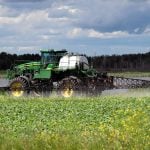Lens-caps off to award-winning photojournalist, Louis Psihoyos who has won an Oscar for his film “The Cove,” the first time a still photojournalist has made the leap to the highest movie award since 2004 when Zana Briski won for “Born Into Brothels: Calcutta’s Red Light Kids.”
The film he directed, “The Cove,” about an annual dolphin hunt in a small town in Japan, his first film, won the Oscar for Best Documentary.
Read Also

Crop profitability looks grim in new outlook
With grain prices depressed, returns per acre are looking dismal on all the major crops with some significantly worse than others.
Psihoyos says he still shoots stills, though he finds filmmaking a much more rewarding and powerful medium. Now he talks as if he sees stills as a secondary function because of that stronger reaction and reward. “People are not going to stand in front of my picture and weep or cheer or laugh.” He recommends moving pictures to every photographer, and “now that I’ve embraced it,” he said, “It’s as natural as picking up a still camera.”
Another very good commercial and editorial still photographer is Vincent Laforet, who made the transition from newspaper photographer to Hollywood commercial director. He has recently released “Reverie,” the first short film photographed with a Canon 5D MKII. Laforet is considered a leading pioneer in using the new technology. People are embracing the new hybrid technology and running with it. Laforet says this camera was probably the most important career changing self-funded shoot that he will likely ever do.
Neither Psihoyos nor Laforet had formal training as a cinematographer, director or producer. They are gifted storytellers who primarily honed their skills from the newspaper and magazine world.
The hardest part about going into filmmaking says Laforet was learning the difference between cinema lighting versus photography lighting, or continuous light versus strobes – many of the principles are the same – but the equipment is very different.
When asked about the future look for still photographers shooting the hybrid cameras, Laforet had this to say.
“I think we’re all going to have a very interesting next few years as still photographers. I think there’s tremendous potential for people out there who have an open mind. Not everyone needs to be a born-filmmaker. I’m not worried about photographers making transitions into video, or their unique version of how stills can transform into video. The only thing that worries me is that publications have a lot to figure out. The time it takes to pre-produce, shoot, and edit video is easily 2 to 4 times more time consuming as a still photography shoot. The gear involved is also significantly more expensive as well. And right now I don’t know that publications are ready to help defray any of those costs. In fact it seems that they want photographers to shoot both stills and video, for the same price. And, that’s not going to be sustainable for anyone, for more than the first assignment.
Once the photographer and even the editor, sees how much work is involved, I hope they will find a way to re-adjust. This clearly won’t be easy given the economy of print… but it’s something that needs to be discussed thoroughly. While you can’t expect photographers (or want them to) produce Hollywood quality pieces, you can’t forget that the audience is used to seeing Hollywood quality work on their television, so we need to make sure that we produce something that is either unique enough or at least good enough to hold their attention. One thing that will never change: people will always gravitate towards original and/or quality content.”
Note: Excerpts from the National Press Photographer’s Association weekly newsletter, “Close up,” and blog, A PhotoEditor by Rob Haggart.

Here’s a still moving shot I made a few weeks back.














